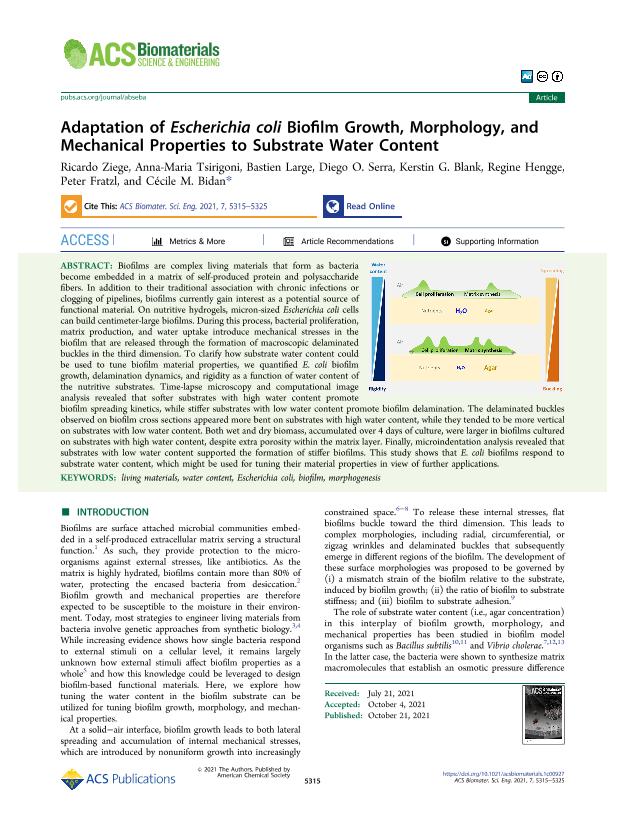Mostrar el registro sencillo del ítem
dc.contributor.author
Ziege, Ricardo
dc.contributor.author
Tsirigoni, Anna Maria
dc.contributor.author
Large, Bastien
dc.contributor.author
Serra, Diego Omar

dc.contributor.author
Blank, Kerstin G.
dc.contributor.author
Hengge, Regine

dc.contributor.author
Fratzl, Peter

dc.contributor.author
Bidan, Cécile M.
dc.date.available
2023-01-26T17:10:48Z
dc.date.issued
2021-11
dc.identifier.citation
Ziege, Ricardo; Tsirigoni, Anna Maria; Large, Bastien; Serra, Diego Omar; Blank, Kerstin G.; et al.; Adaptation of Escherichia coli Biofilm Growth, Morphology, and Mechanical Properties to Substrate Water Content; American Chemical Society; ACS Biomaterials Science and Engineering; 7; 11; 11-2021; 5315-5325
dc.identifier.issn
2373-9878
dc.identifier.uri
http://hdl.handle.net/11336/185802
dc.description.abstract
Biofilms are complex living materials that form as bacteria become embedded in a matrix of self-produced protein and polysaccharide fibers. In addition to their traditional association with chronic infections or clogging of pipelines, biofilms currently gain interest as a potential source of functional material. On nutritive hydrogels, micron-sized Escherichia coli cells can build centimeter-large biofilms. During this process, bacterial proliferation, matrix production, and water uptake introduce mechanical stresses in the biofilm that are released through the formation of macroscopic delaminated buckles in the third dimension. To clarify how substrate water content could be used to tune biofilm material properties, we quantified E. coli biofilm growth, delamination dynamics, and rigidity as a function of water content of the nutritive substrates. Time-lapse microscopy and computational image analysis revealed that softer substrates with high water content promote biofilm spreading kinetics, while stiffer substrates with low water content promote biofilm delamination. The delaminated buckles observed on biofilm cross sections appeared more bent on substrates with high water content, while they tended to be more vertical on substrates with low water content. Both wet and dry biomass, accumulated over 4 days of culture, were larger in biofilms cultured on substrates with high water content, despite extra porosity within the matrix layer. Finally, microindentation analysis revealed that substrates with low water content supported the formation of stiffer biofilms. This study shows that E. coli biofilms respond to substrate water content, which might be used for tuning their material properties in view of further applications.
dc.format
application/pdf
dc.language.iso
eng
dc.publisher
American Chemical Society

dc.rights
info:eu-repo/semantics/openAccess
dc.rights.uri
https://creativecommons.org/licenses/by/2.5/ar/
dc.subject
BIOFILM
dc.subject
ESCHERICHIA COLI
dc.subject
LIVING MATERIALS
dc.subject
MORPHOGENESIS
dc.subject
WATER CONTENT
dc.subject.classification
Biofísica

dc.subject.classification
Ciencias Biológicas

dc.subject.classification
CIENCIAS NATURALES Y EXACTAS

dc.title
Adaptation of Escherichia coli Biofilm Growth, Morphology, and Mechanical Properties to Substrate Water Content
dc.type
info:eu-repo/semantics/article
dc.type
info:ar-repo/semantics/artículo
dc.type
info:eu-repo/semantics/publishedVersion
dc.date.updated
2022-09-19T16:02:28Z
dc.journal.volume
7
dc.journal.number
11
dc.journal.pagination
5315-5325
dc.journal.pais
Estados Unidos

dc.journal.ciudad
Washington
dc.description.fil
Fil: Ziege, Ricardo. Max Planck Institute Of Colloids And Interfaces; Alemania
dc.description.fil
Fil: Tsirigoni, Anna Maria. Max Planck Institute Of Colloids And Interfaces; Alemania
dc.description.fil
Fil: Large, Bastien. Max Planck Institute Of Colloids And Interfaces; Alemania
dc.description.fil
Fil: Serra, Diego Omar. Consejo Nacional de Investigaciones Científicas y Técnicas. Centro Científico Tecnológico Conicet - Rosario. Instituto de Biología Molecular y Celular de Rosario. Universidad Nacional de Rosario. Facultad de Ciencias Bioquímicas y Farmacéuticas. Instituto de Biología Molecular y Celular de Rosario; Argentina
dc.description.fil
Fil: Blank, Kerstin G.. Max Planck Institute Of Colloids And Interfaces; Alemania
dc.description.fil
Fil: Hengge, Regine. Humboldt Universität Zu Berlin; Alemania
dc.description.fil
Fil: Fratzl, Peter. Max Planck Institute Of Colloids And Interfaces; Alemania
dc.description.fil
Fil: Bidan, Cécile M.. Max Planck Institute Of Colloids And Interfaces; Alemania
dc.journal.title
ACS Biomaterials Science and Engineering
dc.relation.alternativeid
info:eu-repo/semantics/altIdentifier/doi/http://dx.doi.org/10.1021/acsbiomaterials.1c00927
Archivos asociados
